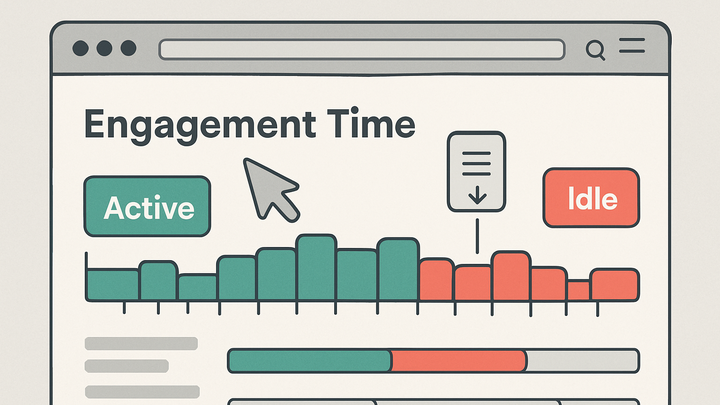Published on 2025-06-28T05:18:03Z
What is Engagement Time? Examples of Tracking Engagement Time
Engagement Time measures the duration users actively interact with your website or application. Unlike total session duration, it only counts periods when the page is in focus and the user performs meaningful actions such as clicks, scrolls, or typing. This metric filters out idle time when users might have the page open but aren’t paying attention, giving you a more accurate view of true engagement.
In a cookie-free context, tools like PlainSignal calculate Engagement Time without relying on third-party cookies, while platforms such as Google Analytics 4 offer built-in engagement metrics. By analyzing Engagement Time across segments—new vs returning users, device types, or traffic sources—you can optimize content, improve user experience, and drive better business outcomes.
Engagement time
Duration of meaningful user interactions on a page, counting only active engagement signals like clicks and scrolling.
Understanding Engagement Time
In this section, we define what Engagement Time is, how it differs from similar metrics, and the key signals that constitute active engagement.
-
Definition
Engagement Time is the accumulated duration when a user actively interacts with your site, such as clicks, typing, and scrolling, excluding idle moments.
-
Dwell time vs engagement time
While Dwell Time tracks the total time a page is open, Engagement Time focuses solely on periods of user interaction.
-
Dwell time
The total time a user’s browser tab or window remains open, even if the user is inactive.
-
Engagement time
Time during which users are actively interacting with page elements, ensuring a more accurate measure of interest.
-
-
Engagement signals
Common engagement signals include clicks, scroll events, form interactions, and keyboard input, all tracked via event listeners.
Why Engagement Time Matters
Engagement Time provides deeper insights into user behavior than basic metrics, helping you optimize content and user experience.
-
Quality of interactions
Higher Engagement Time indicates that users find content valuable and are spending more time exploring it.
-
Seo and algorithmic weighting
Search engines and recommendation algorithms can use engagement signals to rank pages, influencing visibility.
-
Conversion optimization
Understanding when and where users are most engaged can inform CTA placement and design improvements.
Tracking Engagement Time
Various techniques and considerations ensure accurate measurement of Engagement Time across devices and privacy settings.
-
Measurement techniques
Implement event-driven tracking using the Page Visibility API and custom timers to log active engagement periods.
-
Data collection considerations
Account for cookie restrictions, cross-tab sessions, and sampling rates to maintain data integrity.
-
Cross-tab tracking
Use session identifiers or localStorage to stitch engagement data across multiple tabs.
-
Cookie consent
Respect user privacy by deferring engagement tracking until after consent is granted.
-
Examples: PlainSignal and GA4 Implementations
Learn how to set up and interpret Engagement Time metrics in PlainSignal (cookie-free) and Google Analytics 4.
-
PlainSignal setup
Insert the PlainSignal script into your HTML to start capturing Engagement Time automatically.
-
Tracking code
<link rel="preconnect" href="//eu.plainsignal.com/" crossorigin /> <script defer data-do="yourwebsitedomain.com" data-id="0GQV1xmtzQQ" data-api="//eu.plainsignal.com" src="//cdn.plainsignal.com/plainsignal-min.js"></script> -
Interpreting metrics
View the Engagement Time metric in the PlainSignal dashboard under ‘User Engagement’, showing active vs idle time.
-
-
GA4 setup
Use the gtag.js snippet to deploy GA4 and automatically collect engagement metrics out of the box.
-
Gtag configuration
<script async src="https://www.googletagmanager.com/gtag/js?id=G-XXXXXYZ"></script> <script> window.dataLayer = window.dataLayer || []; function gtag(){dataLayer.push(arguments);} gtag('js', new Date()); gtag('config', 'G-XXXXXYZ', { 'send_page_view': true }); </script> -
Report view
Access Engagement metrics in GA4 under Reports → Engagement → Overview, where ‘Average engagement time per session’ is displayed.
-
Best Practices for Engagement Time Analysis
Apply strategic approaches to make the most of Engagement Time data and drive actionable insights.
-
Contextual benchmarks
Compare Engagement Time against industry standards and historical data for meaningful benchmarks.
-
Segment-based analysis
Break down Engagement Time by user segments (e.g., new vs. returning, traffic source) to uncover patterns.
-
Combining quantitative and qualitative data
Pair Engagement Time metrics with session recordings or user surveys to understand the ‘why’ behind the numbers.
